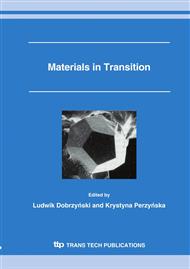[1]
C.G. McKamey, J.H. Devan, P.F. Tortorelli and V.K. Sikka: J. Mater. Res. Materialia Vol. 6(8) (1991) p.1779.
Google Scholar
[2]
Y. Nishino, C. Kumada and S. Asano: Scripta Materialia Vol. 36 (1997) p.461.
Google Scholar
[3]
Y. Nishino: Mater. Sci. Eng. A Vol. 258 (1998) p.50.
Google Scholar
[4]
R.S. Sundar and D.H. Sastry: Intermetalllics Vol. 8 (2000) p.1061.
Google Scholar
[5]
G. Athanassiadis, G. Le Caer, J. Foct and L. Rimlinger: phys. stat. sol. (a) Vol. 40 (1977) p.425.
DOI: 10.1002/pssa.2210400208
Google Scholar
[6]
B.V. Reddy, S.C. Deevi, A.C. Lilly and P.J. Jena: J. Phys.: Condens. Mat. Vol. 13 (2001) p.8363.
Google Scholar
[7]
B.V. Reddy, P.J. Jena and S.C. Deevi: Intermetallics Vol. 8 (2000) p.1197.
Google Scholar
[8]
B.V. Reddy, D.H. Sastry, S.C. Deevi and S.N. Khana: Phys. Rev. B Vol. 64 (2001) p.224419.
Google Scholar
[9]
N. Lakshmi, K. Venugopalan and J. Varma: Phys. Rev. B Vol. 47 (1993) p.14054.
Google Scholar
[10]
S.M. Kim and D.G. Morris: Acta Mater. Vol. 46 (1998) p.2587.
Google Scholar
[11]
D. Satuła, L Dobrzyński, A. Malinowski, K. Szymański and J. Waliszewski: J. Magn. Magn. Mat. Vol. 140-144 (1995) p.61.
Google Scholar
[12]
M. Pugaczowa-Michalska, A. Go and L. Dobrzyński: phys. stat. sol (b) Vol. 242 (2005) p.461.
Google Scholar
[13]
O.K. Andersen, O. Jepsen, and M. Sob: Electronic Structure and Its Applications (Springer, Berlin 1987 ed. M. Yuassoff) p.2.
Google Scholar
[14]
O.K. Andersen and O. Jepsen: Phys. Rev. Lett. Vol. 53 (1984) p.2571.
Google Scholar
[15]
U. von Barth and L. Hedin: J. Phys. C Vol. 5 (1972) p.1629.
Google Scholar
[16]
C.D. Hu and D. C. Langreth: Phys Scr. Vol. 32 (1985) p.391.
Google Scholar
[17]
A. Abragam: The Principles of Nuclear Magnetism (Oxford University, Oxford 1961).
Google Scholar
[18]
H. Bremers, Ch. Jarms and J. Hesse: Conference Proceedings, Vol. 50, International Conference on the Application of the Mössbauer effect, (ICAME 95), (1996) p.319.
Google Scholar
[19]
M. I. Darby: J. Phys. F: Metal. Phys. 7 (1977) p. L69.
Google Scholar
[20]
D. C. Price: J. Phys. F: Metal. Phys. 8 (1978) p.933.
Google Scholar
[21]
S. Mager, E. Wieser, T. Zemcik, O. Schneeweiss, P.N. Stetsenko and V. Surikov: phys. stat. sol. (a) Vol. 52 (1979) p.249.
DOI: 10.1002/pssa.2210520127
Google Scholar
[22]
E. Wieser and S. Mager: phys. stat. sol. (a) Vol. 40 (1977) p.497.
Google Scholar


